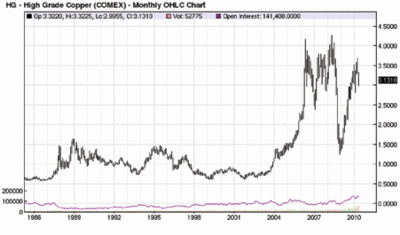While many commentators have focused on the massive rebound in global stock markets since the 2009 lows, the spectacular rise in the prices of industrial metals has been overlooked.
The main industrial metals I'd like to draw attention to are copper, nickel, aluminium and zinc, with copper, which has rebounded by more than 165 per cent in just over 12 months, being my main focus.
Firstly, copper is not that rare, with 88 per cent of the supply mined and 12 per cent made up from scrap recycling. Copper is mined around the world, with America mining 41 per cent of the supply, closely followed by Asia with 31 per cent. The biggest consumer is still the building trade, accounting for 48 per cent, then engineering with 24 per cent and electrical with 17 per cent. The price of copper can be used as a barometer for the health of global industry.
As you can see from the graph of copper (I am using the NYMEX listing not the LME), the price topped at $4.00 per lb then crashed down to $1.40 before a great comeback in 2009 and then making what I believe is a top in March 2010 at $3.70.
 |
The bounce-back in copper has more to do with speculation and cheap financing than just a rebounding economy. Agreed, China and the emerging markets are consuming copper, but it is questionable how much is being consumed and how much is being stored in warehouses by speculators.
The 5 Year LME Copper Warehouse Stocks figures show that copper in storage is near a five-year high, so there is certainly no shortage of the metal. I also see world production exceeding demand in 2010, so there will be no need to draw down supplies; and while the earthquake in Chile did cause some temporary disruption to copper mining, I do not see this being significant.
So while I don't see Copper going back down to $1.50, I can see no justification for a price anywhere near $3.70. In fact, an average price of $2.50 to $2.75 is what I am looking for, somewhere towards the end of 2010 or by the first quarter of 2011. A stronger US dollar and a reduction of speculation and storing copper will help to get the price back down.
Among other industrial metals, aluminium is also well supplied, if not over-supplied, as is zinc and nickel. Again, with all three, you have to question how much of the demand is speculation and how much is consumption.
The Short Industrial Metals exchange-traded fund (LSE: SIME) offers you a way to profit from falling prices. It's an inverse ETF, so as prices drop the ETF goes up. Over the past 12 months, it has been down because the metals have been up.
The ETF is made up of aluminium 36 per cent, copper 35 per cent, zinc 15 per cent and nickel 14 per cent. You can buy it via any online broker, and some spread betting companies will allow a spread bet. I suggest going for a December contact. You can also short the individual metals, for example, using the Short Copper ETF (LSE: SCOP).
As regular readers will know, I have been very bullish on Brazil, and since the March 2009 lows, the Bovespa has bounced by over 90 per cent.
While the story for Brazil remains intact, I really don't see much upside for the next six to eight months. Therefore, I have closed out all my exposure to Brazil and will look at buying back, hopefully at lower levels.
When the media starts to talk more about investing in the BRIC nations/economies and new funds are launched to allow smaller retail clients to participate, for me, that is a sign to be cautious.
Remember, Brazil is very closely tied to commodities and its new best friend, China. Slowdowns in China are very quickly felt in exports of grains, metals and fertiliser. If you look at a chart of metals giant Companhia Vale do Rio Doce (NYSE:VALE), you will see it looks very similar to the Bovespa index.
The content of this site is copyright 2016 Financial Spread Betting Ltd. Please contact us if you wish to reproduce any of it.